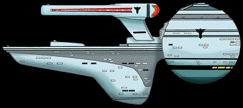
![]()
![]()

Class and Type: Olympic-class
Medical Cruiser
Commissioning Date: 2366
Lead Engineer: Colin
K. Smith
Hull Characteristics
Size: 6 (239 meters long, 23 decks)
Resistance: 4
Structural Points: 120
Operational Characteristics
Crew/Passengers: 160/1,200 (200 medical personnel and 1,000 patients)
[6 pwr/round]
Computers: 6
[6 pwr/round]
Transporters: 8 personnel, 7 cargo, 5 emergency
[10 pwr/round]
Tractor Beams: 1 av, 1 fv
[2/rating used]
Propulsion and Power Characteristics
Warp System: 6.0/8.0/9.0 (12 hours)
[2 pwr/warp factor]
Impulse System: .75 c/.9 c
[7/9 pwr/round]
Power: 140
Sensor Systems
Long-range Sensors: +2/15 light-years
[6 pwr/round]
Lateral Sensors: +2/2 light-years
[4 pwr/round]
Navigational Sensors: +2
[5 pwr/round]
Sensor Skill: 5
Weapons Systems
Type IX Phaser:
Range: 10/30,000/100,000/300,000
Arc: All (720 degrees)
Accuracy: 4/5/7/10
Damage: 18
Power: [18]
Type II Photon Torpedoes:
Number: 150
Launchers: 1 ad, 1 fd
Spread: 4
Arc: Forward or aft, but are self-guided
Range: 15/300,000/1,000,000/3,500,000
Accuracy: 4/5/7/10
Damage: 20
Power: [5]
Weapons Skill: 5
Defensive Systems
Starfleet Deflector Shield
Protection: 50/70
Power: [50]
Description and Notes
Fleet data: The Olympic-class stems from a Starfleet
proposal issued in 2360 for a new class of medical vessel to replace the aging Nightingale-class.
The new ship was to be an improvement on the Nightingale in every respect. It
would incorporate a complete Starfleet standard mobile hospital capable of caring for up
to 1,000 patients, compared to 560 on a Nightingale. The warp and impulse drives,
computers, and other systems were also to be up to the latest standards.
Starfleet chose the Olympic from several submissions in 2363, and construction
began on the first of the class in the same year. The ship was launched in November of
2365, and completed its shakedown successfully in 2366. Series production began at once,
and sixteen ships have now joined the fleet. The Olympic have extensive
transporter and shuttle facilities allowing them to get a large number of patients
emergency care in a matter of minutes. To supplement the medical staff, the extensive
computer banks have the ability to generate multiple Emergency Medical Hologram (EMH)
programs, should the need arise. These were the first vessels to employ this system. The Olympic
have proved very successful in service, and are popular with their crews. Their early
careers were relatively uneventful, although the U.S.S. Olympic herself rescued
several hundred survivors from the immediate aftermath of the battle against the Borg at
Wolf 359.
Noteworthy vessels / service records / encounters: U.S.S. Olympic, prototype,
rescued survivors of Wolf 359; U.S.S. Pasteur; U.S.S. Nobel; U.S.S. Hope;
and twelve other vessels built since 2366.
Author's Notes
The description here is a modification of that presented by Graham Kennedy. The original
description is Copyright Graham Kennedy, 27th August 1998. Used with the consent of the
author.
This material is no longer being updated. Official canon material from the publishers, Last Unicorn Games, is now available. Please see the product The Price of Freedom: The United Federation of Planets Sourcebook (ISBN: 1-888953-03-9) from your local retailer for the most accurate and official version of this material. This material remains online as a service to our readers.
Star Trek® and all related marks ™, ®, & © Paramount Pictures. Star Trek The RPG™ and all related products are © Last Unicorn Games, Inc. Individual works are the property of respective authors and may not be reproduced without permission. HTML code, layout, and custom images are property of TrekRPGNet and may not be reproduced without permission. See the legal page for more information.